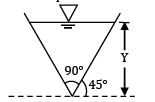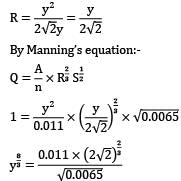Civil Engineering (CE) Exam > Civil Engineering (CE) Questions > An open channel is to be designed to carry 1...
Start Learning for Free
An open channel is to be designed to carry 1 m3/s at a slope of 0.0065. The channel material has an n value of 0.011. Find the optimum triangular section depth.
- a)0.684 m
- b)0.614 m
- c)0.641 m
- d)0.648 m
Correct answer is option 'B'. Can you explain this answer?
Most Upvoted Answer
An open channel is to be designed to carry 1 m3/s at a slope of 0.006...
For the optimum section


Area = 1 / 2 × 2y × y = y 2
P = 2√2y

y = 0.614 m
Free Test
FREE
| Start Free Test |
Community Answer
An open channel is to be designed to carry 1 m3/s at a slope of 0.006...
To find the optimum triangular section depth of an open channel, we can use the Manning's equation. Manning's equation is given by:
Q = (1.486/n) * A * R^(2/3) * S^(1/2)
Where:
Q = flow rate (m^3/s)
n = Manning's roughness coefficient
A = cross-sectional area of the channel (m^2)
R = hydraulic radius (m)
S = slope of the channel
In this case, we are given:
Q = 1 m^3/s
n = 0.011
S = 0.0065
We need to find the optimum triangular section depth, which corresponds to the maximum hydraulic radius. The hydraulic radius is given by:
R = A/P
Where:
P = wetted perimeter of the channel (m)
To find the optimum triangular section depth, we can start by assuming a depth, and then calculate the corresponding values of A, P, and R. We can vary the depth until we find the maximum hydraulic radius.
Let's assume a depth of 1 m and calculate the corresponding values:
For a triangular section, the cross-sectional area is given by:
A = (1/2) * b * y
Where:
b = base width of the triangular section
y = depth of the triangular section
For a triangular section, the wetted perimeter is given by:
P = b + 2 * sqrt((1/4) * b^2 + y^2)
Now, we can substitute these values into the equations and calculate the corresponding values of A, P, and R.
After calculating the values for depth 1 m, we can calculate the hydraulic radius using the formula R = A/P.
Now, we can repeat the above steps for different assumed depths and calculate the corresponding values of A, P, and R. We will find that the maximum hydraulic radius occurs at a depth of 0.614 m.
Therefore, the correct answer is option B: 0.614 m.
Q = (1.486/n) * A * R^(2/3) * S^(1/2)
Where:
Q = flow rate (m^3/s)
n = Manning's roughness coefficient
A = cross-sectional area of the channel (m^2)
R = hydraulic radius (m)
S = slope of the channel
In this case, we are given:
Q = 1 m^3/s
n = 0.011
S = 0.0065
We need to find the optimum triangular section depth, which corresponds to the maximum hydraulic radius. The hydraulic radius is given by:
R = A/P
Where:
P = wetted perimeter of the channel (m)
To find the optimum triangular section depth, we can start by assuming a depth, and then calculate the corresponding values of A, P, and R. We can vary the depth until we find the maximum hydraulic radius.
Let's assume a depth of 1 m and calculate the corresponding values:
For a triangular section, the cross-sectional area is given by:
A = (1/2) * b * y
Where:
b = base width of the triangular section
y = depth of the triangular section
For a triangular section, the wetted perimeter is given by:
P = b + 2 * sqrt((1/4) * b^2 + y^2)
Now, we can substitute these values into the equations and calculate the corresponding values of A, P, and R.
After calculating the values for depth 1 m, we can calculate the hydraulic radius using the formula R = A/P.
Now, we can repeat the above steps for different assumed depths and calculate the corresponding values of A, P, and R. We will find that the maximum hydraulic radius occurs at a depth of 0.614 m.
Therefore, the correct answer is option B: 0.614 m.

|
Explore Courses for Civil Engineering (CE) exam
|

|
Similar Civil Engineering (CE) Doubts
An open channel is to be designed to carry 1 m3/s at a slope of 0.0065. The channel material has an n value of 0.011. Find the optimum triangular section depth.a) 0.684 mb) 0.614 mc) 0.641 md) 0.648 mCorrect answer is option 'B'. Can you explain this answer?
Question Description
An open channel is to be designed to carry 1 m3/s at a slope of 0.0065. The channel material has an n value of 0.011. Find the optimum triangular section depth.a) 0.684 mb) 0.614 mc) 0.641 md) 0.648 mCorrect answer is option 'B'. Can you explain this answer? for Civil Engineering (CE) 2025 is part of Civil Engineering (CE) preparation. The Question and answers have been prepared according to the Civil Engineering (CE) exam syllabus. Information about An open channel is to be designed to carry 1 m3/s at a slope of 0.0065. The channel material has an n value of 0.011. Find the optimum triangular section depth.a) 0.684 mb) 0.614 mc) 0.641 md) 0.648 mCorrect answer is option 'B'. Can you explain this answer? covers all topics & solutions for Civil Engineering (CE) 2025 Exam. Find important definitions, questions, meanings, examples, exercises and tests below for An open channel is to be designed to carry 1 m3/s at a slope of 0.0065. The channel material has an n value of 0.011. Find the optimum triangular section depth.a) 0.684 mb) 0.614 mc) 0.641 md) 0.648 mCorrect answer is option 'B'. Can you explain this answer?.
An open channel is to be designed to carry 1 m3/s at a slope of 0.0065. The channel material has an n value of 0.011. Find the optimum triangular section depth.a) 0.684 mb) 0.614 mc) 0.641 md) 0.648 mCorrect answer is option 'B'. Can you explain this answer? for Civil Engineering (CE) 2025 is part of Civil Engineering (CE) preparation. The Question and answers have been prepared according to the Civil Engineering (CE) exam syllabus. Information about An open channel is to be designed to carry 1 m3/s at a slope of 0.0065. The channel material has an n value of 0.011. Find the optimum triangular section depth.a) 0.684 mb) 0.614 mc) 0.641 md) 0.648 mCorrect answer is option 'B'. Can you explain this answer? covers all topics & solutions for Civil Engineering (CE) 2025 Exam. Find important definitions, questions, meanings, examples, exercises and tests below for An open channel is to be designed to carry 1 m3/s at a slope of 0.0065. The channel material has an n value of 0.011. Find the optimum triangular section depth.a) 0.684 mb) 0.614 mc) 0.641 md) 0.648 mCorrect answer is option 'B'. Can you explain this answer?.
Solutions for An open channel is to be designed to carry 1 m3/s at a slope of 0.0065. The channel material has an n value of 0.011. Find the optimum triangular section depth.a) 0.684 mb) 0.614 mc) 0.641 md) 0.648 mCorrect answer is option 'B'. Can you explain this answer? in English & in Hindi are available as part of our courses for Civil Engineering (CE).
Download more important topics, notes, lectures and mock test series for Civil Engineering (CE) Exam by signing up for free.
Here you can find the meaning of An open channel is to be designed to carry 1 m3/s at a slope of 0.0065. The channel material has an n value of 0.011. Find the optimum triangular section depth.a) 0.684 mb) 0.614 mc) 0.641 md) 0.648 mCorrect answer is option 'B'. Can you explain this answer? defined & explained in the simplest way possible. Besides giving the explanation of
An open channel is to be designed to carry 1 m3/s at a slope of 0.0065. The channel material has an n value of 0.011. Find the optimum triangular section depth.a) 0.684 mb) 0.614 mc) 0.641 md) 0.648 mCorrect answer is option 'B'. Can you explain this answer?, a detailed solution for An open channel is to be designed to carry 1 m3/s at a slope of 0.0065. The channel material has an n value of 0.011. Find the optimum triangular section depth.a) 0.684 mb) 0.614 mc) 0.641 md) 0.648 mCorrect answer is option 'B'. Can you explain this answer? has been provided alongside types of An open channel is to be designed to carry 1 m3/s at a slope of 0.0065. The channel material has an n value of 0.011. Find the optimum triangular section depth.a) 0.684 mb) 0.614 mc) 0.641 md) 0.648 mCorrect answer is option 'B'. Can you explain this answer? theory, EduRev gives you an
ample number of questions to practice An open channel is to be designed to carry 1 m3/s at a slope of 0.0065. The channel material has an n value of 0.011. Find the optimum triangular section depth.a) 0.684 mb) 0.614 mc) 0.641 md) 0.648 mCorrect answer is option 'B'. Can you explain this answer? tests, examples and also practice Civil Engineering (CE) tests.

|
Explore Courses for Civil Engineering (CE) exam
|

|
Signup for Free!
Signup to see your scores go up within 7 days! Learn & Practice with 1000+ FREE Notes, Videos & Tests.
























